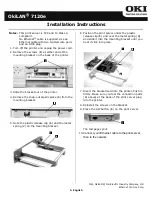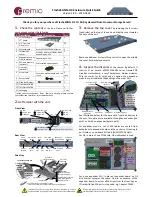
v
Serial connector:
Connect a 9-pin serial device to this connector. The serial port
is shared with the integrated management module (IMM). The IMM can take
control of the shared serial port to redirect serial traffic, using Serial over LAN
(SOL).
v
USB connectors:
Connect a USB device, such as a USB mouse, keyboard, or
other device to any of these connectors.
v
Ethernet connectors:
Use either of these connectors to connect the server to a
network. When you use the Ethernet 1 connector, the network can be shared
with the IMM through a single network cable.
v
NMI button:
Press this button to force a nonmaskable interrupt to the
microprocessor. You might have to use a pen or the end of a straightened paper
clip to press the button. It allows you to blue screen the server and take a
memory dump (use this button only when directed by the IBM service support).
v
PCI slot 1:
Insert a low-profile PCI Express or PCI-X adapter into this slot.
Standard models of the server come with two PCI Express riser assemblies. You
can purchase an optional PCI-X riser-card assembly with bracket if you want to
install a PCI-X adapter in this slot.
v
PCI slot 2:
Insert a three-quarter length, full-height PCI Express or PCI-X
adapter into this slot. Standard models of the server come with two PCI Express
riser assemblies. You can purchase an optional PCI-X riser-card assembly with
bracket if you want to install a PCI-X adapter in this slot.
Server power features
When the server is connected to an ac power source but is not turned on, the
operating system does not run, and all core logic except for the service processor
(the integrated management module) is shut down; however, the server can
respond to requests to the service processor, such as a remote request to turn on
the server. The power-on LED flashes to indicate that the server is connected to ac
power but is not turned on.
Turning on the server
Approximately 5 seconds after the server is connected to ac power, one or more
fans might start running to provide cooling while the server is connected to power
and the power-on button LED flashes quickly. Approximately 1 to 3 minutes after
the server is connected to ac power, the power-control button becomes active (the
power-on LED flashes slowly), and one or more fans might start running to provide
cooling while the server is connected to power. You can turn on the server by
pressing the power-control button.
The server can also be turned on in any of the following ways:
v
If a power failure occurs while the server is turned on, the server will restart
automatically when power is restored.
v
If your operating system supports the Wake on LAN feature, the Wake on LAN
feature can turn on the server.
Note:
When 4 GB or more of memory (physical or logical) is installed, some
memory is reserved for various system resources and is unavailable to the
operating system. The amount of memory that is reserved for system
resources depends on the operating system, the configuration of the server,
and the configured PCI devices.
Turning off the server
When you turn off the server and leave it connected to ac power, the server can
respond to requests to the service processor, such as a remote request to turn on
16
IBM System x3250 M3 Types 4251, 4252, and 4261: Installation and User’s Guide
Содержание 425162U
Страница 1: ...IBM System x3250 M3 Types 4251 4252 and 4261 Installation and User s Guide...
Страница 2: ......
Страница 3: ...IBM System x3250 M3 Types 4251 4252 and 4261 Installation and User s Guide...
Страница 7: ...Index 85 Contents v...
Страница 8: ...vi IBM System x3250 M3 Types 4251 4252 and 4261 Installation and User s Guide...
Страница 34: ...18 IBM System x3250 M3 Types 4251 4252 and 4261 Installation and User s Guide...
Страница 100: ...84 IBM System x3250 M3 Types 4251 4252 and 4261 Installation and User s Guide...
Страница 105: ......
Страница 106: ...Part Number 81Y6118 Printed in USA 1P P N 81Y6118...
















































